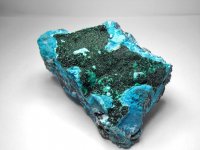black circles on blue
Amazon Forum Fav 👍
Attachments
Last edited:



Euhedral crystals are those which have a characteristically recognisable shape as a result of having multiple, well-formed, sharp faces. They typically crystallize in open environments where they are not cramped by anything which constrains their final shape. The opposite is ‘anhedral’ crystals, where there are no well-defined crystal faces in a recognisable shape and those form in environments where the crystal shape is constrained by crowding. For example crystals trying to form in magma (molten rock) as it cools may grow so closely together that they touch one another and there is then no free space for them to adopt a recognisable shape. When crystals fall somewhere between the two and have only a partially recognisable shape, we call them ‘subhedral’.
Small rounded crystalline habits like you’re showing have no sharply defined crystal faces but also have not been constrained. We wouldn’t regard them as either euhedral or anhedral. Their shape arises from forming around a tiny nucleus in layers, giving them a globular appearance, for which the proper geological term is ‘botryoidal’ (derived from the Greek word for a bunch of grapes). It’s a common crystal habit for hematite and a number of other minerals including malachite and chrysocolla.